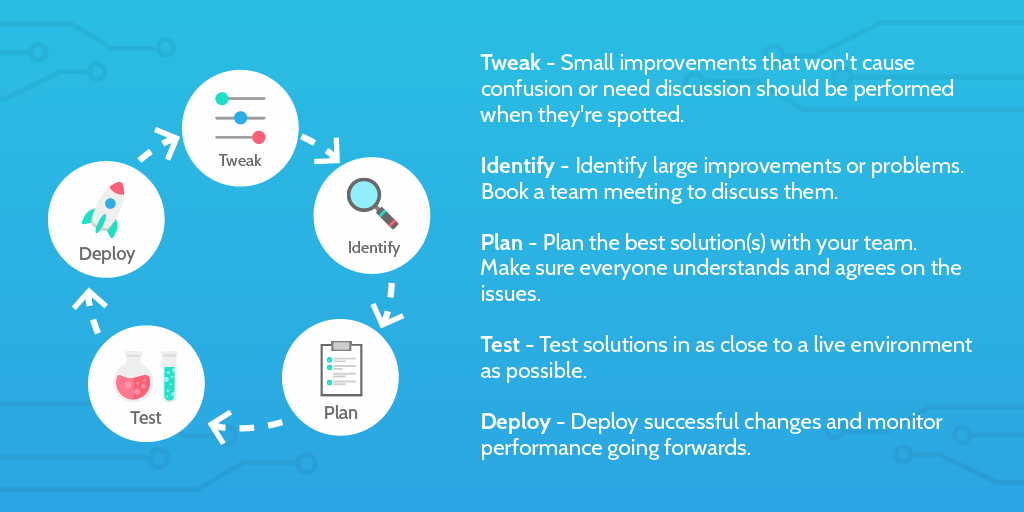
In a study of 400 businesses in the UK and US, global analyst firm IDC established that 23% of employees don’t understand a core part of their job. Combined with the potential damage that human error can cause, it’s easy to see why it’s important to make sure that your processes are being followed to the letter.
Still, nobody enjoys hearing the term “ensure compliance” when it comes to their team. It’s cold, impersonal, and conjures up images of school students being sent to detention or prisoners under strict watch, and if your team feels the same then their morale will quickly plummet.
Here at Process Street, we’re well versed in the problems with documenting, managing, and deploying your processes. That’s why this post will take care of those compliance problems by giving you some killer tips to make sure your team sticks to their methods without alienating them with harsh policies.
Let’s dive right in!
How to ensure compliance with processes
Use business process management software
It’s all well and good to document and deploy processes to guide your employees’ actions, but without a way to monitor, track, organize, and easily review them everything could buckle and collapse.
That’s where business process management software comes in.

Whether you’re trying to provide an overview of your processes and review them in action or ensure compliance by checking that they’re being followed to the letter, BPM software is one of the best investments you can make for your team.
“[After deploying a BPM program, we saw] 95% success rates with the projects (compared to numbers closer to 25% for overall IT projects and ERP projects)” – George Van Antwerp, speaking about research from Gartner, Basic BPM Stats
As for what kind of software to use, it’s almost always better to go for dedicated BPM tools rather than trying to bend others to the purpose.
Programs such as Microsoft Word and services like Google Docs are tempting to use when deciding how to document your processes. Most people (if not everyone) who has used a computer will be familiar enough with them to use them without in-depth training, and everyone has access to the program so nobody has to sign up for a new service. Heck, they’re pretty much everybody’s go-to writing app and have been for some time.
However, in a professional setting these systems strain under the weight of supporting the number of documents required while being flexible enough to still be easy to use.
To name a few problems with this type of business process documentation:
- Process files are difficult to manage
- Individual process runs require separate copies of the document (creating large and messy digital or physical files)
- It’s difficult to ensure that everyone is using the most recent process version
- Processes are often ignored due to the impracticality of using them
Dedicated process documentation software does not suffer from these issues.
For example, Process Street provides a central location for storing your processes which lets your whole team access everything they need to by logging into our app. Process templates let you add as much detail as you want to each task with images, videos, and other rich media, without cluttering things to the point of being unusable.
In other words, if you want to take your business processes to the next level, you need to be using the right software. Click here to sign up for a free Process Street account today.
Store important files using a cloud storage service
I’ve already touched on the need to store your processes where your entire team can access them, and the same is true for any and all important documents and projects. After all, processes can’t be followed when nobody can access the necessary resources.
Cloud storage software is a great way to make sure that everyone can access what they need in order to collaborate or to provide a backup plan in the event of an emergency. In this way you can ensure compliance without bothering anyone – you’re making things better by removing friction from their work.
At the very least this will make it easier to access the same documents to effectively work together. It also means that any issues with conflicting time zones between employees (e.g. in remote teams) won’t result in files being inaccessible. Since everyone is working from the same repository, everyone should also be working with the most recent version of any and all files and folders.
There is also a slightly more morbid benefit in that this drastically reduces the danger of the bus factor. This states how resilient your projects are to losing one or more key members.
“One day we got word that one of the senior-most developers had literally been hit by a bus while crossing the street (thankfully he made a full recovery, but it certainly slowed down that part of the team as he was out for 8 weeks or so).” – Luke Bearl, The Bus Factor
For example, let’s say that you’re running through a client onboarding process but are unavailable shortly after performing the initial outreach. Rather than having your team repeat what you’ve already done with the client (or, worse still, forget them entirely), with cloud storage features they will be able to carry on from where you left off.
In theory you shouldn’t have to deal with this issue, but absences from work can be hard to predict at the best of times. Even if you’re planning around a team member’s holiday time or someone calls in sick for the day, it pays to have files stored in cloud software to ease some of the practical issues with accessing work.
If you need a little help choosing the right cloud storage software, check out our post showing off Dropbox vs Google Drive.
Give file access to all and edit permissions to key figures
There’s no point in using process documentation software or cloud storage services if there’s no-one checking the permission levels set up for each file and folder. This is one of the most frustrating parts of deploying a new process, as telling a team to change their method only for them to not have access to the new resources is a recipe for disaster.

If people don’t have access to the processes, resources, and work that they need to, they will either take shortcuts or be unable to work entirely. In either case, processes become useless because they’re not being followed.
Having said that, it can be beneficial to everyone to limit the permissions of some so that they can only see, access, and edit what they need to. That way you can keep everyone’s view clear of information that’s not relevant (or too sensitive) for them to see, letting them focus on what they need to know.
Equally, limiting permission levels and checking on them periodically is a great way to secure files against unwanted viewing and access. Sensitive information can be protected by completely hiding it, and items such as processes can be protected from bad changes by giving edit permission to only a select few.
This is yet another great aspect of BPM software as opposed to traditional programs like Microsoft Word. Many (Process Street included) allow you to freely set what everyone can see, access, and edit, whereas Word (and the native Windows file storage) lacks everything but a password protection feature for individual files. To demonstrate, take a look at Process Street’s permission levels for users below:

Make note of any small corrections
While it’s important to protect against unwanted changes to your processes, it’s equally vital that your processes can be altered without too much resistance if the need arises. If small corrections require 5 team meetings and permission from the CEO then the update will take forever to happen, and in the meantime everyone else will likely take their own different shortcuts.
This is what makes processes break down and become useless – there’s no point in having a set method to follow if employees are taking shortcuts because the documentation is out of date or flawed.
To prevent this problem you need to let your team deploy small changes to processes by themselves without too much friction. Not everyone will need access, but by letting a select few trusted employees edit processes relevant to their team, you make it much less likely that shortcuts will be taken.

Any changes should be mentioned in a group chat to keep the team up to date, and ideally recorded in notes for the next team meeting. That way any specific details or affected employees can be discussed with the attention they need.
To learn more, check out our post on continuous improvement.
Host meetings for large problems or changes
Speaking of meetings, hosting one is the best way to make sure that everyone knows what the current version of your processes are and to hear any feedback on issues with them.
It’s easy to get complacent and make assumptions when following processes that have been performed dozens or hundreds of times before, which makes it all the more difficult for a team to adjust to any changes in their routine. To combat this, changes and updates can be discussed in team meetings where everyone is present and will hear what’s been said.
The best way to go about this is to highlight what’s different and then go through how it will affect each team member to make sure that everyone knows what they need to do going forward.
Team meetings are great for covering another problem with putting processes into practice; that some issues will be unpredictable.
Despite best efforts, some issues and mistakes will always slip through the testing phase and affect the results of a process in a live environment. Instead of ignoring them or scrapping the entire thing, a meeting gives a platform for the entire team to voice their concerns about a certain aspect or confusion with the instructions provided. This means that the process can then be updated and followed instead of being ignored and forgotten.
Don’t punish process deviation for the sake of it
This is a big point in making usable processes, and it’s often ignored due to it not fitting with traditional ideas of processes. Business processes are often seen as “the best way to do X”, and so deviation from them is automatically punished and adherence re-enforced.
This is a terrible practice. If someone isn’t following a process then it’s usually not the fault of the person. It’s a fault of the system.
An employee won’t just give up on performing tasks in a certain way for the sake of it – there is always a reason behind it. It’s your job to talk to them and find out why they deviated from the process in the way that they did, and figure out a way to prevent that problem from happening again.

Did they stop because of lacking permissions? Make sure that everyone’s permissions are checked updated. Were they bored by a wall of text or long task? Try splitting it up with other rich media or into smaller tasks. Was the process too basic to cover their niche case? Update it to cover it for future reference.
Even if the issue is nothing to do with the process, the fact is that the outcome remains the same. The process is ignored and then the deviant process becomes the norm.
That’s why teams shouldn’t be punished for there being a fault or inefficiency with the system. Doing so will just discourage them from speaking up in future, making any and all issues silent and far more dangerous.
You don’t have to be harsh to ensure compliance
Although it can be hard to see their logic sometimes, an employee who doesn’t follow protocol isn’t necessarily lazy or ignorant. Even the best of us fall prey to human error, and that’s assuming that nothing in the process is confusing or set up incorrectly.
That’s why it’s important to have a tough, but fair attitude when trying to ensure compliance with your processes. Yes, it’s good to have everything performed predictably, but it’s better to have something done right than to have a flawed method followed.
If you’d like to know more about managing your processes, check out our other resources below on similar topics:
- 8 Critical Change Management Models to Evolve and Survive
- The Complete Guide to Business Process Management
- What is a Process? A Non-Boring Guide for Regular People
- How Processes Protect Your Business From Crashing and Burning
- Why the Normalization of Deviance is Hurting Your Company
How do you ensure compliance in your own team? I’d love to hear from you in the comments below!







 Workflows
Workflows Projects
Projects Data Sets
Data Sets Forms
Forms Pages
Pages Automations
Automations Analytics
Analytics Apps
Apps Integrations
Integrations
 Property management
Property management
 Human resources
Human resources
 Customer management
Customer management
 Information technology
Information technology



Ben Mulholland
Ben Mulholland is an Editor at Process Street, and winds down with a casual article or two on Mulholland Writing. Find him on Twitter here.